Welcome to Sudoku Today!
Today Sudoku contains very many types of variant Sudoku, more types of Sudoku puzzles are still under continuous development, please continue to pay attention to Sudoku today.
Today's Sudoku
24-April-2024
Extra Regions Sudoku
- Place a digit from 1 to 9 into each of the empty squares so that each digit appears exactly once in each of the rows, columns and the nine outlined 3x3 regions.
- The connected shaded cells contain each digit from 1 to 9.
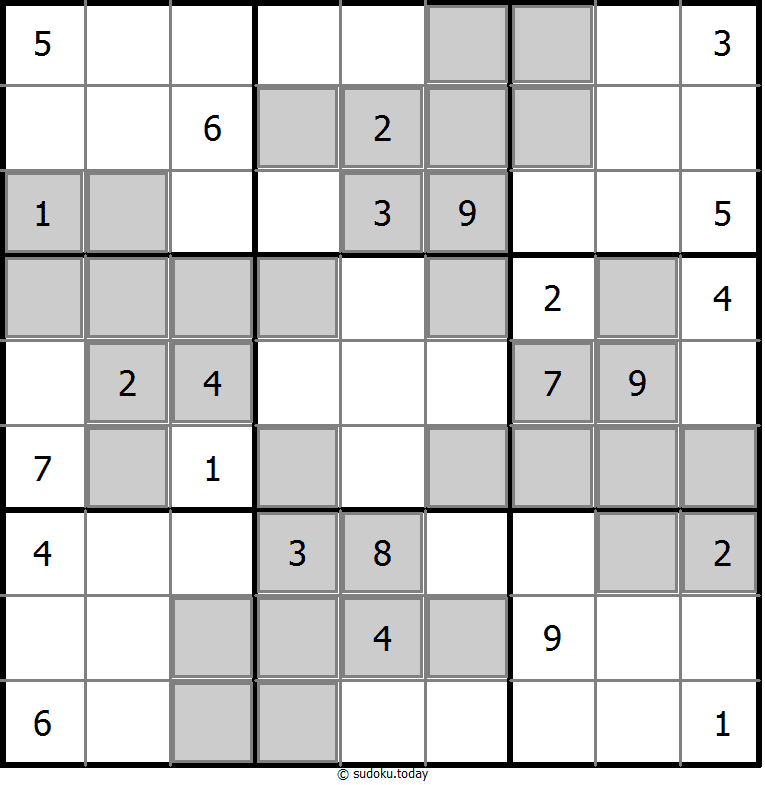
Extra Regions Sudoku
- Place a digit from 1 to 9 into each of the empty squares so that each digit appears exactly once in each of the rows, columns and the nine outlined 3x3 regions.
- The connected shaded cells contain each digit from 1 to 9.
Greater Than Kropki Sudoku
- Place a digit from 1 to 9 into each of the empty squares so that each digit appears exactly once in each of the rows, columns and the nine outlined 3x3 regions.
- In all cases where two digits have a consecutive value or one digit is two times as big as the other digit (or both), a greater than sign is placed. Digits have to be placed in accordance with the sign.
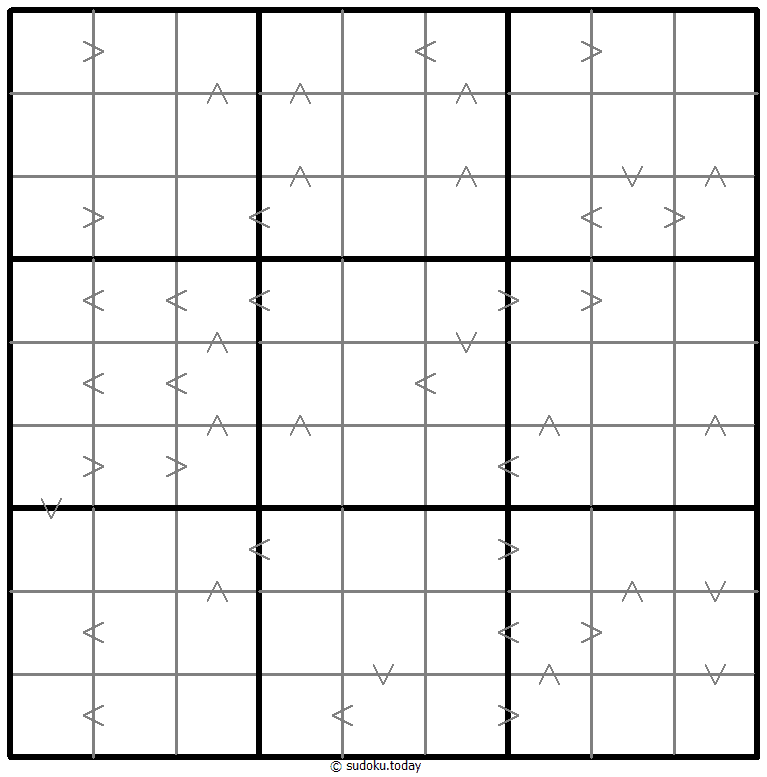
Greater Than Kropki Sudoku
- Place a digit from 1 to 9 into each of the empty squares so that each digit appears exactly once in each of the rows, columns and the nine outlined 3x3 regions.
- In all cases where two digits have a consecutive value or one digit is two times as big as the other digit (or both), a greater than sign is placed. Digits have to be placed in accordance with the sign.
Ten-Eleven Sudoku
- Place a digit from 1 to 9 into each of the empty squares so that each digit appears exactly once in each of the rows, columns and the nine outlined 3x3 regions.
- A dot between two cells indicates that the sum of the numbers in these cells is 10 or 11. If no dot between two cells the sum of the numbers in these cells must not be 10 or 11.
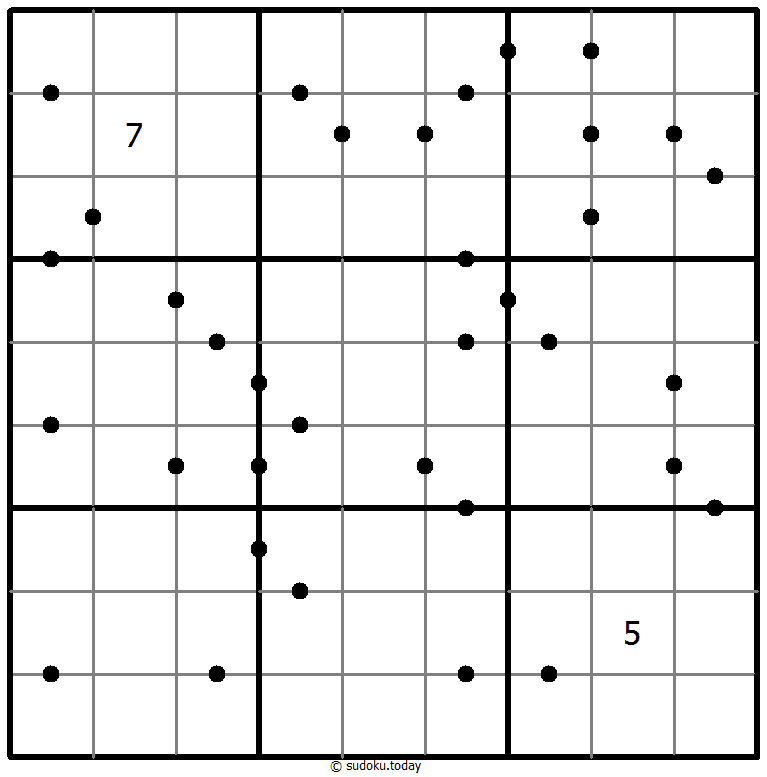
Ten-Eleven Sudoku
- Place a digit from 1 to 9 into each of the empty squares so that each digit appears exactly once in each of the rows, columns and the nine outlined 3x3 regions.
- A dot between two cells indicates that the sum of the numbers in these cells is 10 or 11. If no dot between two cells the sum of the numbers in these cells must not be 10 or 11.
Staircase Sudoku
- Place a digit from 1 to 9 into each of the empty squares so that each digit appears exactly once in each of the rows, columns and the nine outlined 3x3 regions.
- Rows and columns span across the gaps in the diagram.
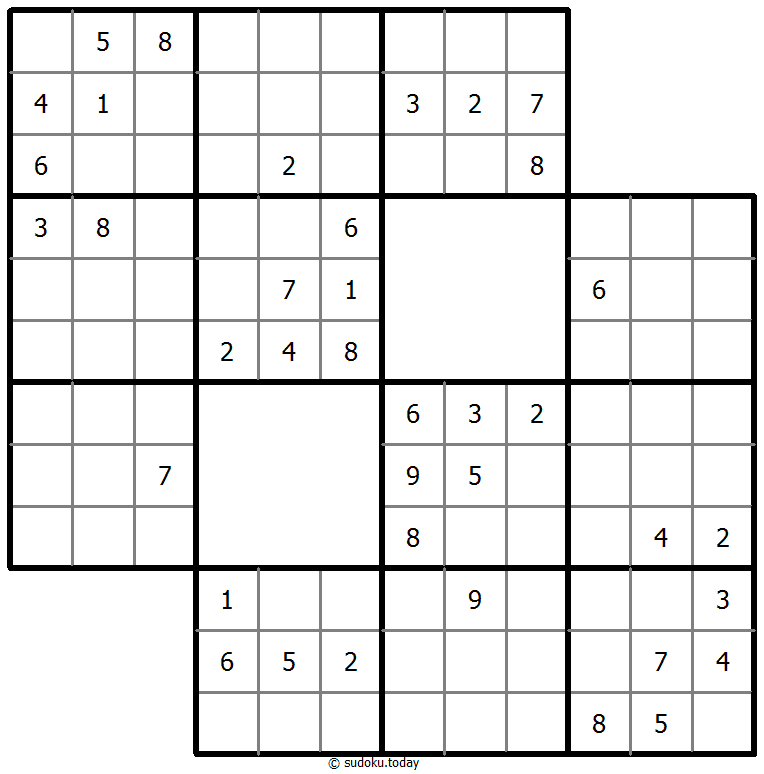
Staircase Sudoku
- Place a digit from 1 to 9 into each of the empty squares so that each digit appears exactly once in each of the rows, columns and the nine outlined 3x3 regions.
- Rows and columns span across the gaps in the diagram.
Differences Sudoku
- Place a digit from 1 to 9 into each of the empty squares so that each digit appears exactly once in each of the rows, columns and the nine outlined 3x3 regions.
- A number between two cells indicates the difference of the numbers in these cells. A number between four cells indicates the difference between two diagonally adjacent cells, either top left + right bottom (\) or top right + bottom left (/). If one of the characters < or > is specified the apex of the angle points to the smaller of these numbers.
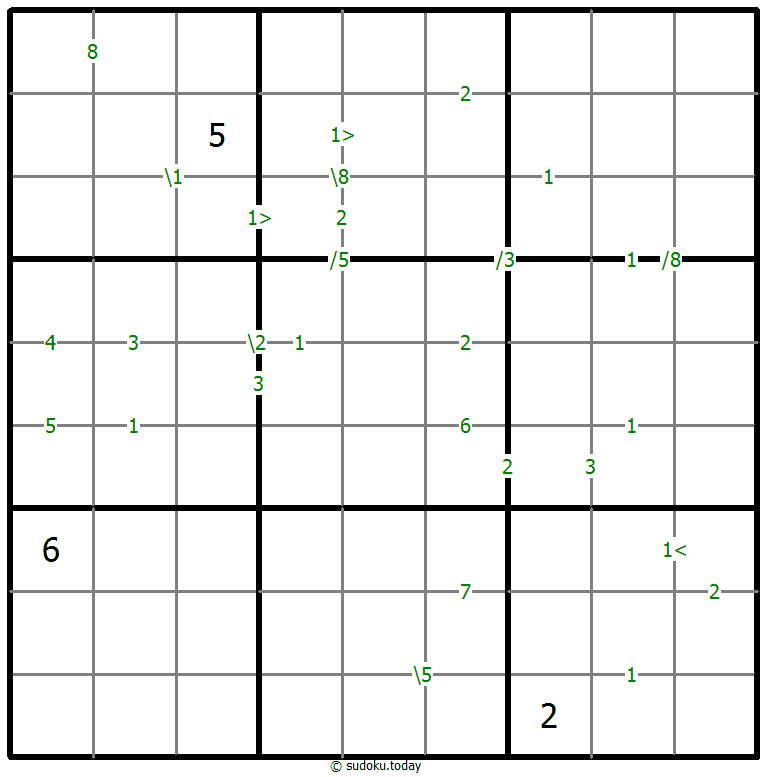
Differences Sudoku
- Place a digit from 1 to 9 into each of the empty squares so that each digit appears exactly once in each of the rows, columns and the nine outlined 3x3 regions.
- A number between two cells indicates the difference of the numbers in these cells. A number between four cells indicates the difference between two diagonally adjacent cells, either top left + right bottom (\) or top right + bottom left (/). If one of the characters < or > is specified the apex of the angle points to the smaller of these numbers.
Exclude Sudoku
- Place a digit from 1 to 9 into each of the empty squares so that each digit appears exactly once in each of the rows, columns and the nine outlined 3x3 regions.
- Numbers in the red circle are not allowed appears in four squares which is nearby the intersection of row and column red circles.
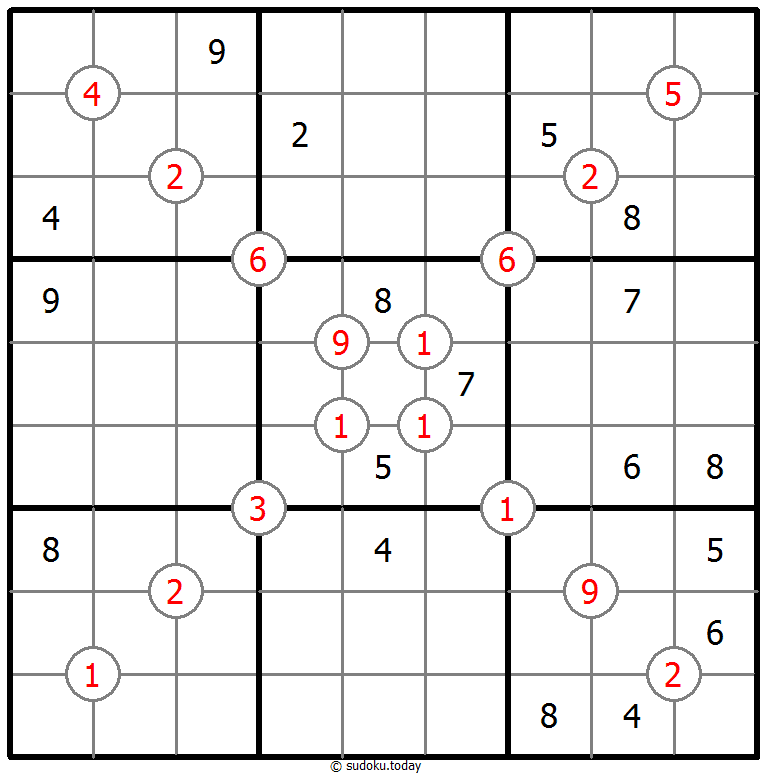
Exclude Sudoku
- Place a digit from 1 to 9 into each of the empty squares so that each digit appears exactly once in each of the rows, columns and the nine outlined 3x3 regions.
- Numbers in the red circle are not allowed appears in four squares which is nearby the intersection of row and column red circles.
Group Sum Sudoku
- Place a digit from 1 to 9 into each of the empty squares so that each digit appears exactly once in each of the rows, columns and the nine outlined 3x3 regions.
- Each number at the intersection of four cells is the sum of digits in those four cells.
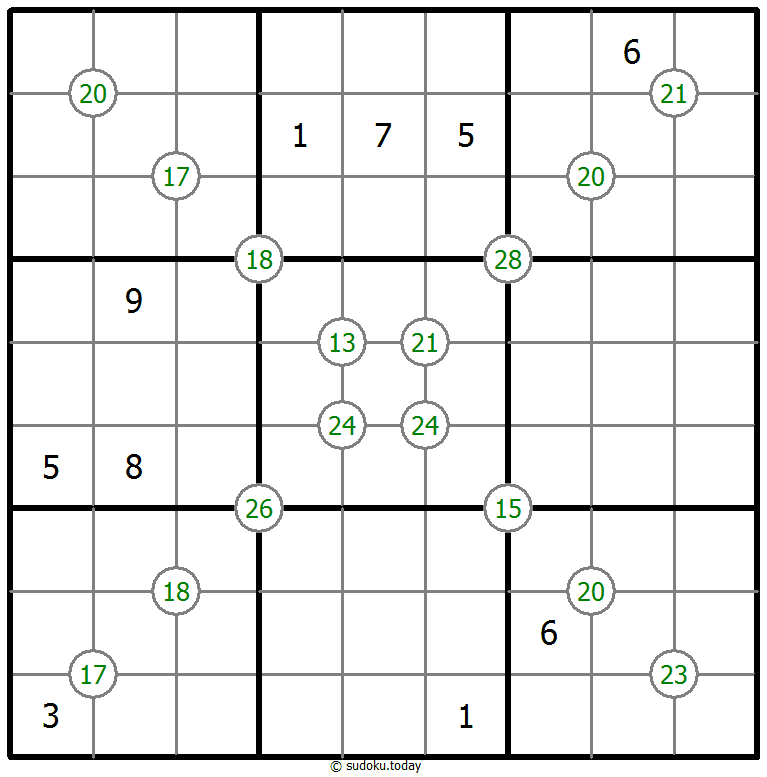
Group Sum Sudoku
- Place a digit from 1 to 9 into each of the empty squares so that each digit appears exactly once in each of the rows, columns and the nine outlined 3x3 regions.
- Each number at the intersection of four cells is the sum of digits in those four cells.
Arrow Sudoku
- Place a digit from 1 to 9 into each of the empty squares so that each digit appears exactly once in each of the rows, columns and the nine outlined 3x3 regions.
- The sum of the digits along the path of each arrow equals the digit in the circled cell. Digits may repeat within an arrow shape.
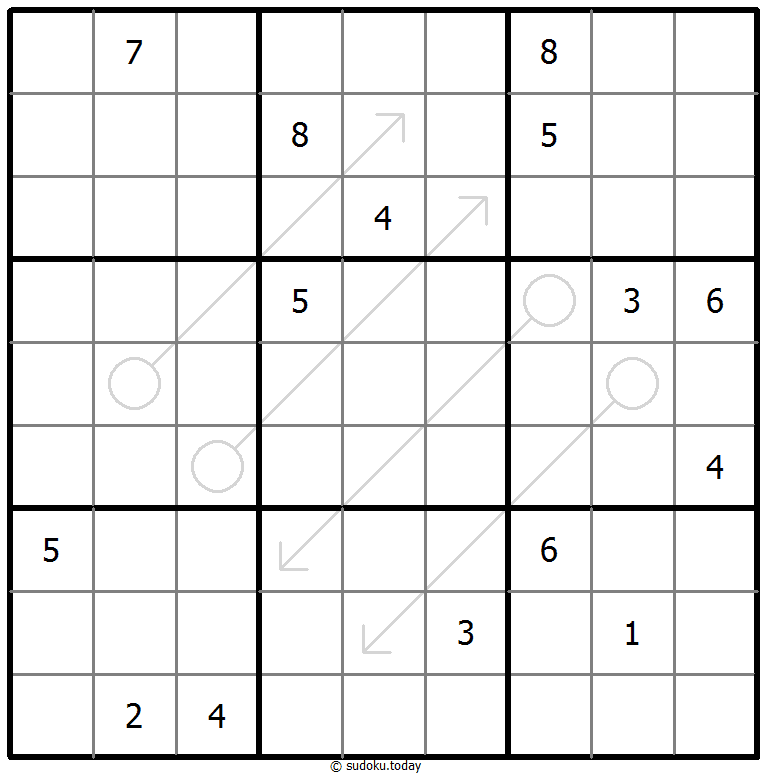
Arrow Sudoku
- Place a digit from 1 to 9 into each of the empty squares so that each digit appears exactly once in each of the rows, columns and the nine outlined 3x3 regions.
- The sum of the digits along the path of each arrow equals the digit in the circled cell. Digits may repeat within an arrow shape.
Non-Consecutive Sudoku
- Place a digit from 1 to 9 into each of the empty squares so that each digit appears exactly once in each of the rows, columns and the nine outlined 3x3 regions.
- Digits in adjacent cells cannot be consecutive.
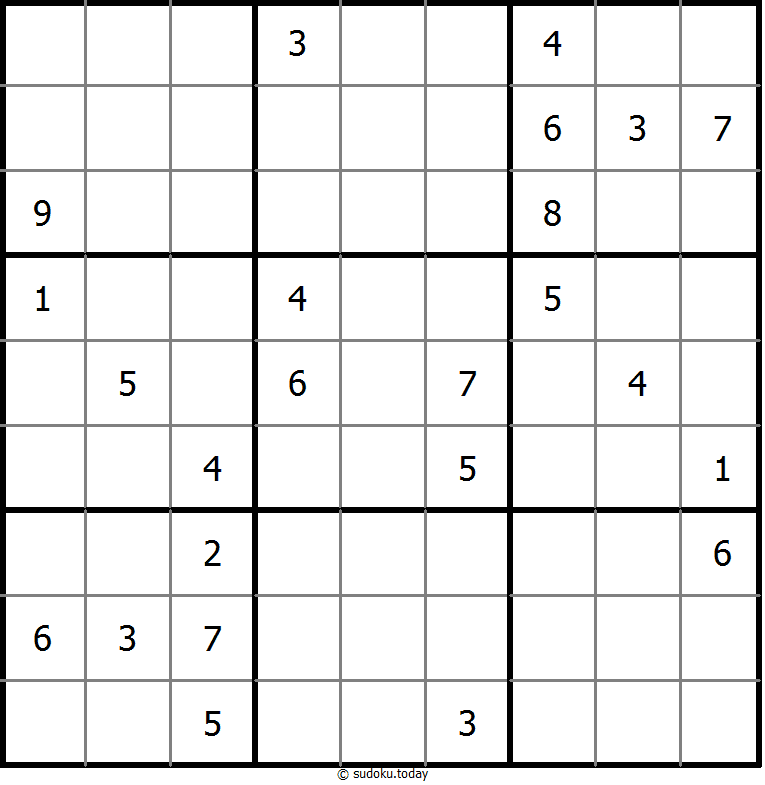
Non-Consecutive Sudoku
- Place a digit from 1 to 9 into each of the empty squares so that each digit appears exactly once in each of the rows, columns and the nine outlined 3x3 regions.
- Digits in adjacent cells cannot be consecutive.
Quotients Sudoku
- Place a digit from 1 to 9 into each of the empty squares so that each digit appears exactly once in each of the rows, columns and the nine outlined 3x3 regions.
- A number between two cells indicates the quotient of the numbers in these cells. A number between four cells indicates the quotient between two diagonally adjacent cells, either top left + right bottom (\) or top right + bottom left (/).
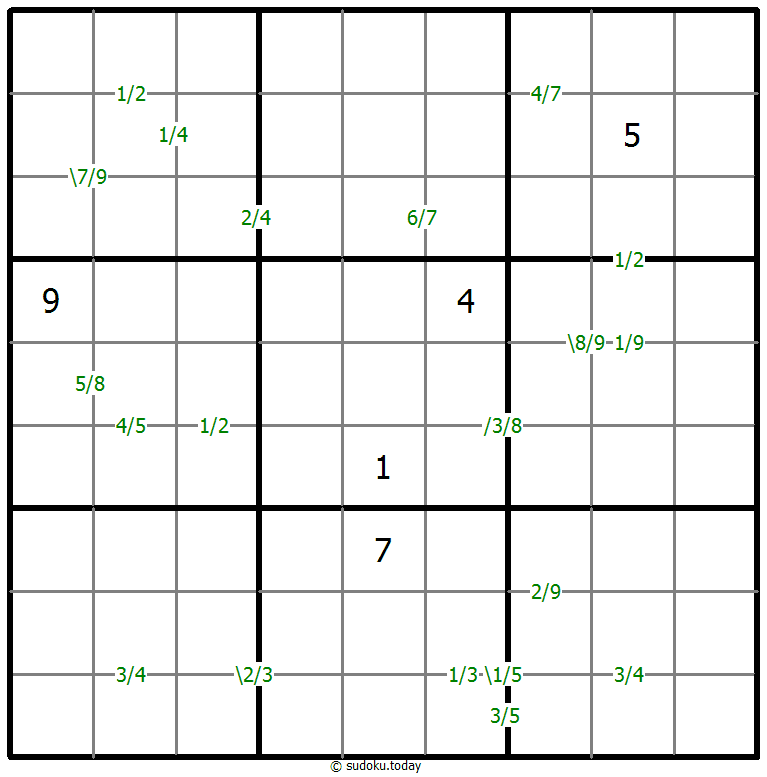
Quotients Sudoku
- Place a digit from 1 to 9 into each of the empty squares so that each digit appears exactly once in each of the rows, columns and the nine outlined 3x3 regions.
- A number between two cells indicates the quotient of the numbers in these cells. A number between four cells indicates the quotient between two diagonally adjacent cells, either top left + right bottom (\) or top right + bottom left (/).
Little killer sudoku
- Place a digit from 1 to 9 into each of the empty squares so that each digit appears exactly once in each of the rows, columns and the nine outlined 3x3 regions.
- Numbers with arrows indicate sum of the numbers in each direction.
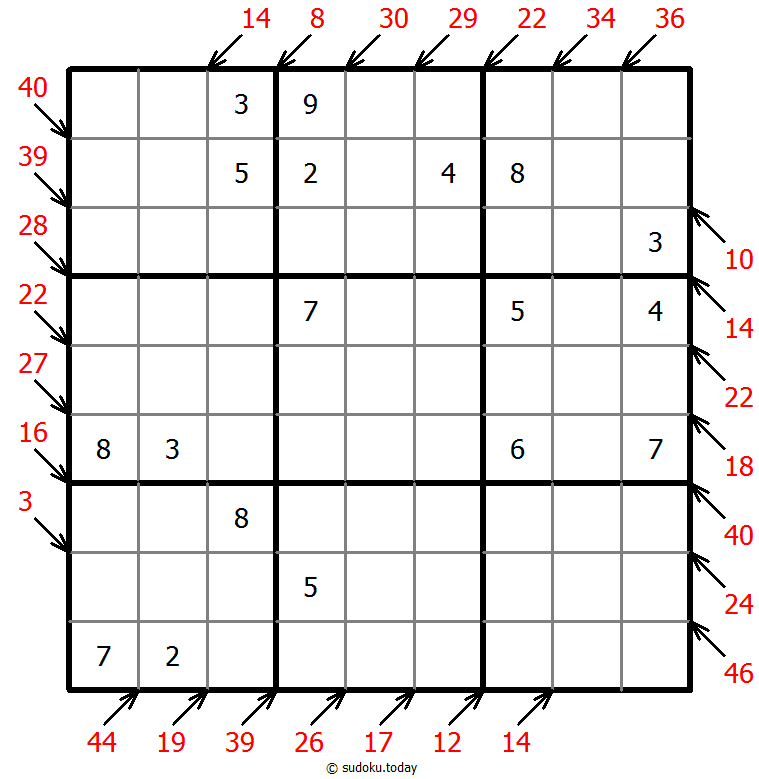
Little killer sudoku
- Place a digit from 1 to 9 into each of the empty squares so that each digit appears exactly once in each of the rows, columns and the nine outlined 3x3 regions.
- Numbers with arrows indicate sum of the numbers in each direction.
Sum Frame Sudoku
- Place a digit from 1 to 9 into each of the empty squares so that each digit appears exactly once in each of the rows, columns and the nine outlined 3x3 regions.
- Digits outside the grid indicate the sum of the first 3 digits in the corresponding direction.
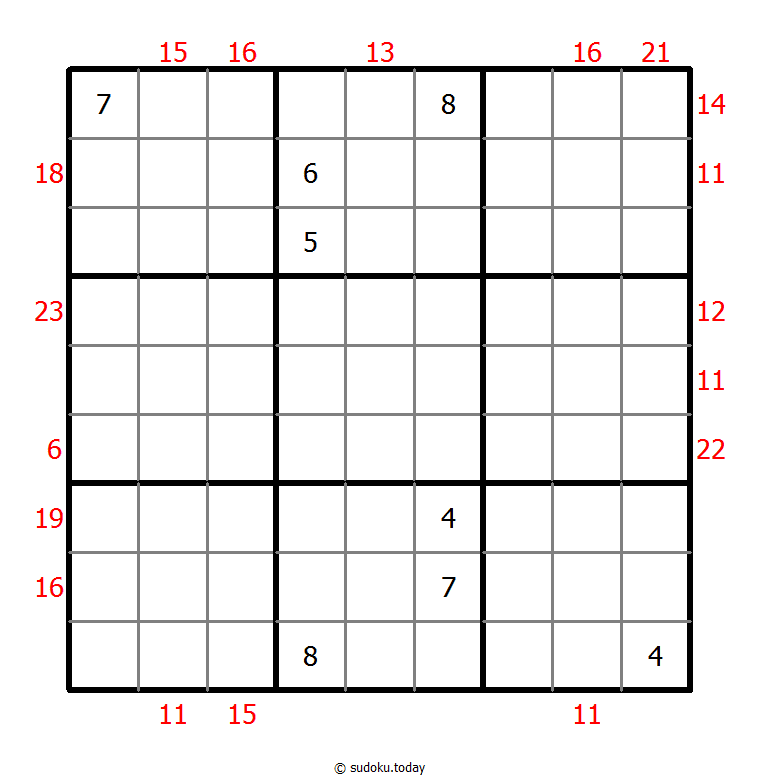
Sum Frame Sudoku
- Place a digit from 1 to 9 into each of the empty squares so that each digit appears exactly once in each of the rows, columns and the nine outlined 3x3 regions.
- Digits outside the grid indicate the sum of the first 3 digits in the corresponding direction.
Mirror Sudoku
- Place a digit from 1 to 9 into each of the empty squares so that each digit appears exactly once in each of the rows, columns and the nine outlined 3x3 regions.
- The four corner boxes contain the same digit in symmetric positions about the centre.
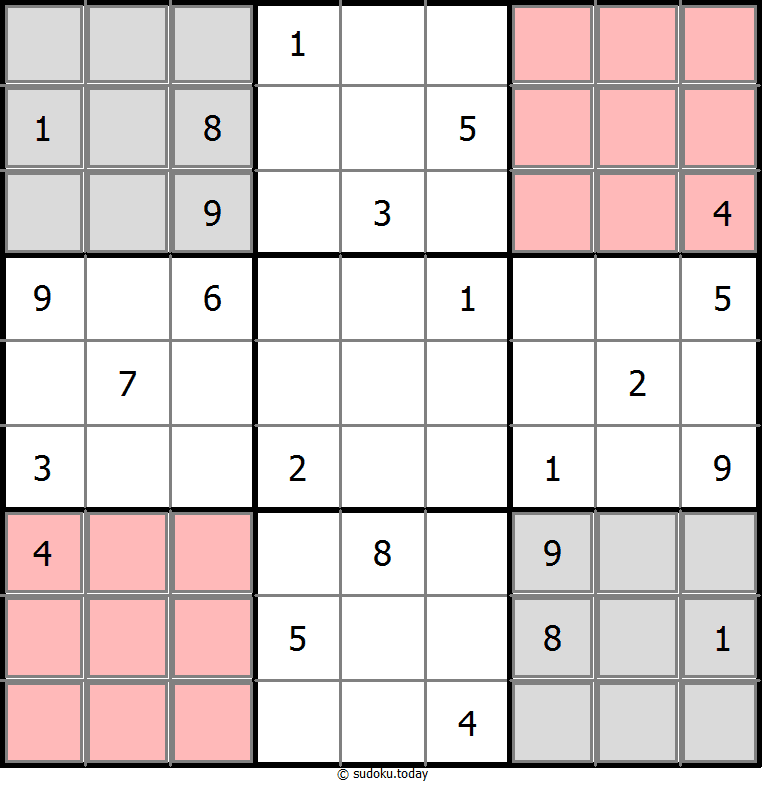
Mirror Sudoku
- Place a digit from 1 to 9 into each of the empty squares so that each digit appears exactly once in each of the rows, columns and the nine outlined 3x3 regions.
- The four corner boxes contain the same digit in symmetric positions about the centre.
XV Sudoku
- Place a digit from 1 to 9 into each of the empty squares so that each digit appears exactly once in each of the rows, columns and the nine outlined 3x3 regions.
- Adjacent cells with digits summing to 5 are marked by V, while those summing to 10 are marked by X. All possible V and X are marked.
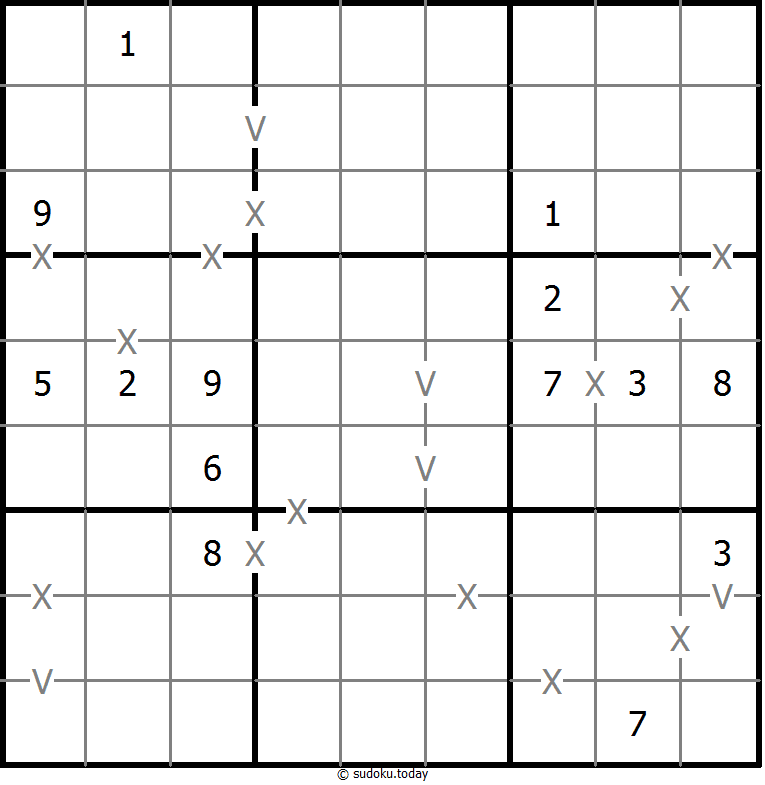
XV Sudoku
- Place a digit from 1 to 9 into each of the empty squares so that each digit appears exactly once in each of the rows, columns and the nine outlined 3x3 regions.
- Adjacent cells with digits summing to 5 are marked by V, while those summing to 10 are marked by X. All possible V and X are marked.
Maximin Sudoku
- Place a digit from 1 to 9 into each of the empty squares so that each digit appears exactly once in each of the rows, columns and the nine outlined 3x3 regions.
- A number at the edge of the diagram indicates the difference between the highest and the lowest number in the first three cells in the corresponding row or column.
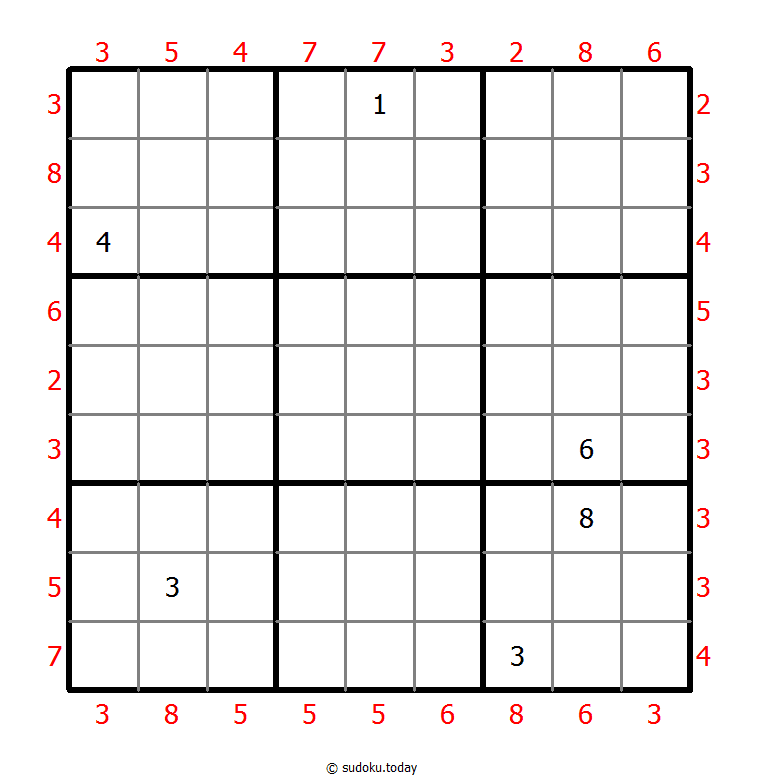
Maximin Sudoku
- Place a digit from 1 to 9 into each of the empty squares so that each digit appears exactly once in each of the rows, columns and the nine outlined 3x3 regions.
- A number at the edge of the diagram indicates the difference between the highest and the lowest number in the first three cells in the corresponding row or column.
Count different Sudoku
- Place a digit from 1 to 9 into each of the empty squares so that each digit appears exactly once in each of the rows, columns and the nine outlined 3x3 regions.
- Arrows and numbers outside gridding means how many different numbers in corresponding direction grid.
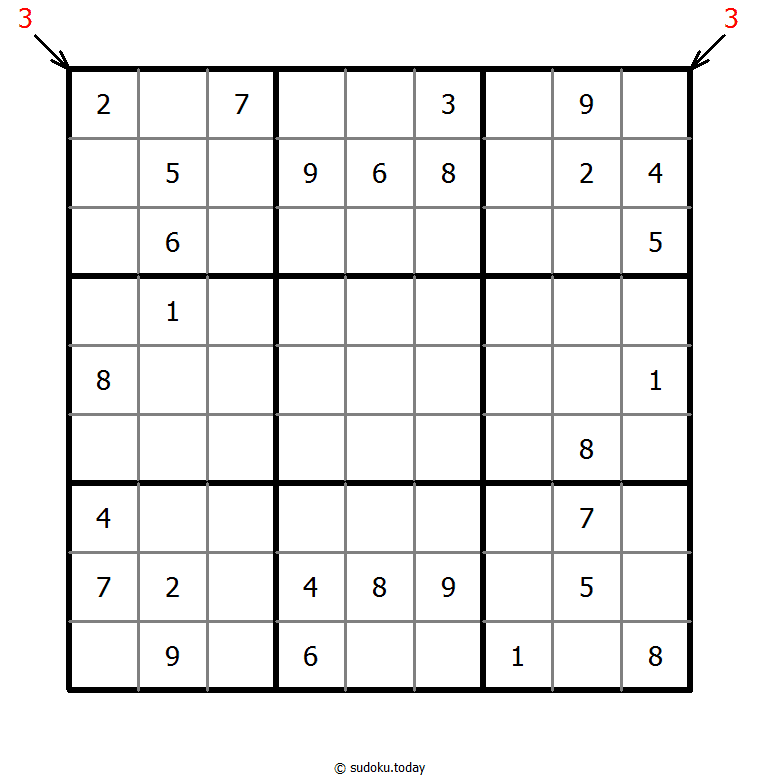
Count different Sudoku
- Place a digit from 1 to 9 into each of the empty squares so that each digit appears exactly once in each of the rows, columns and the nine outlined 3x3 regions.
- Arrows and numbers outside gridding means how many different numbers in corresponding direction grid.
Skyscrapers Sudoku
- Place a digit from 1 to 9 into each of the empty squares so that each digit appears exactly once in each of the rows, columns and the nine outlined 3x3 regions.
- Consider each number to be the height of a building. The numbers outside the grid indicate how many buildings can be seen when looking in that direction (taller buildings conceal smaller buildings behind them).
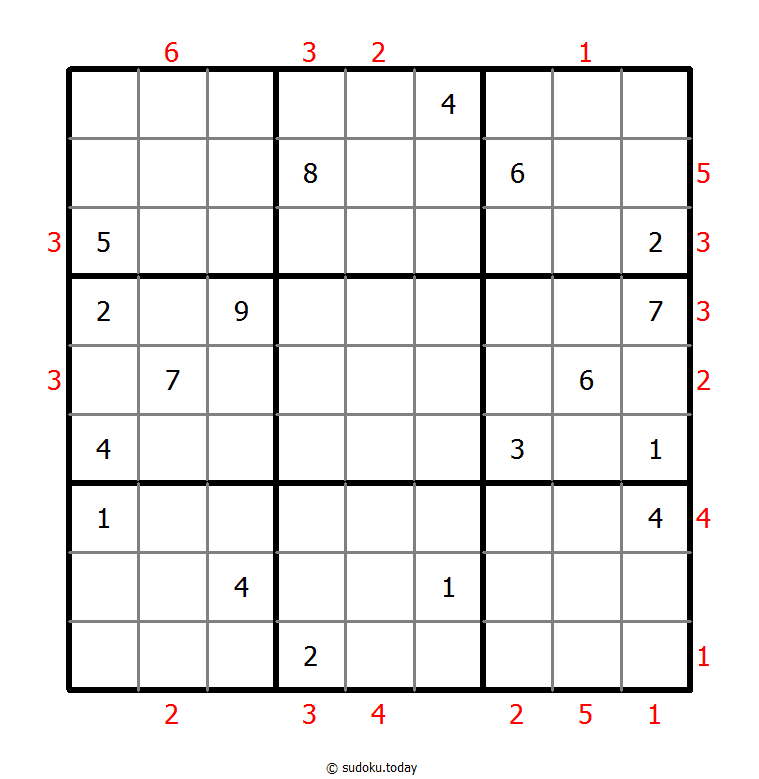
Skyscrapers Sudoku
- Place a digit from 1 to 9 into each of the empty squares so that each digit appears exactly once in each of the rows, columns and the nine outlined 3x3 regions.
- Consider each number to be the height of a building. The numbers outside the grid indicate how many buildings can be seen when looking in that direction (taller buildings conceal smaller buildings behind them).
Creasing Sudoku
- Place a digit from 1 to 9 into each of the empty squares so that each digit appears exactly once in each of the rows, columns and the nine outlined 3x3 regions.
- Digits along each line are monotonically increasing or decreasing.
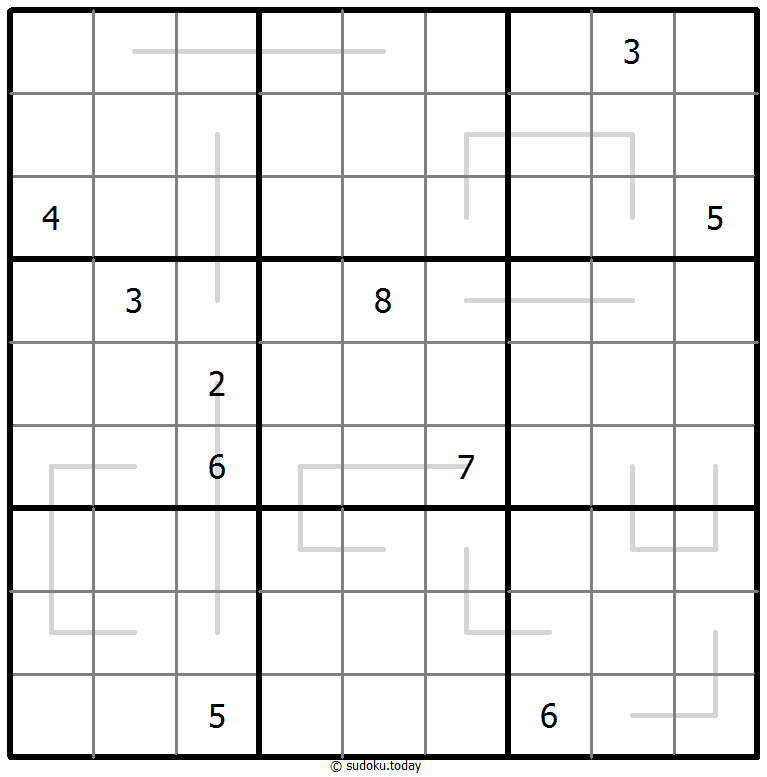
Creasing Sudoku
- Place a digit from 1 to 9 into each of the empty squares so that each digit appears exactly once in each of the rows, columns and the nine outlined 3x3 regions.
- Digits along each line are monotonically increasing or decreasing.
Answer 8 sudoku
- Place a digit from 1 to 9 into each of the empty squares so that each digit appears exactly once in each of the rows, columns and the nine outlined 3x3 regions.
- A dot between two cells indicates that the result of at least one of the basic operations (addition, subtraction, multiplication, division) of the numbers in these two cells is 8. Is the dot missing, no one of the basic operations results in an 8.
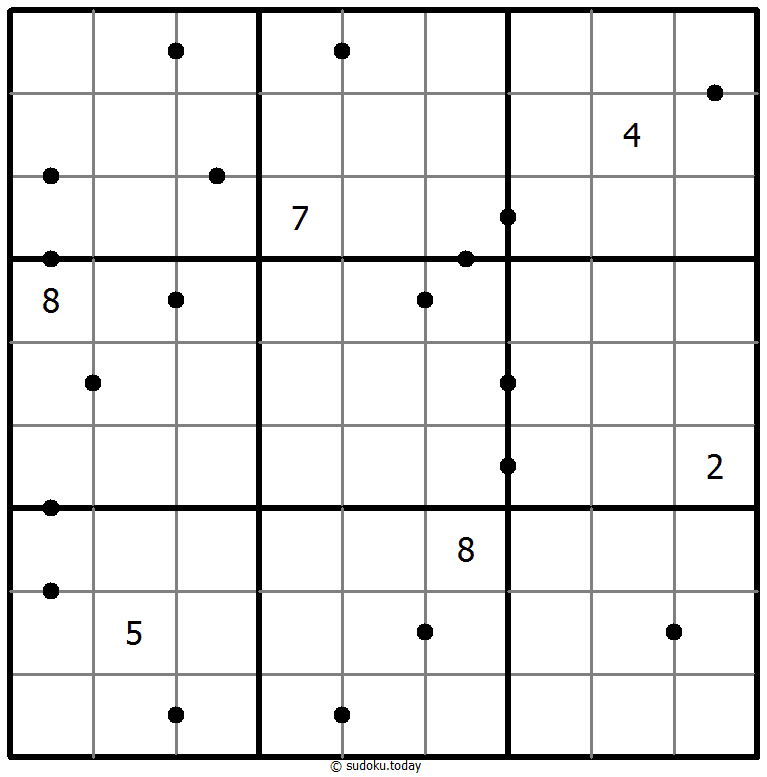
Answer 8 sudoku
- Place a digit from 1 to 9 into each of the empty squares so that each digit appears exactly once in each of the rows, columns and the nine outlined 3x3 regions.
- A dot between two cells indicates that the result of at least one of the basic operations (addition, subtraction, multiplication, division) of the numbers in these two cells is 8. Is the dot missing, no one of the basic operations results in an 8.
Consecutive Sudoku
- Place a digit from 1 to 9 into each of the empty squares so that each digit appears exactly once in each of the rows, columns and the nine outlined 3x3 regions.
- There are some dots between cells. The numbers on each side of a dot must always be consecutive. All possible dots are marked.
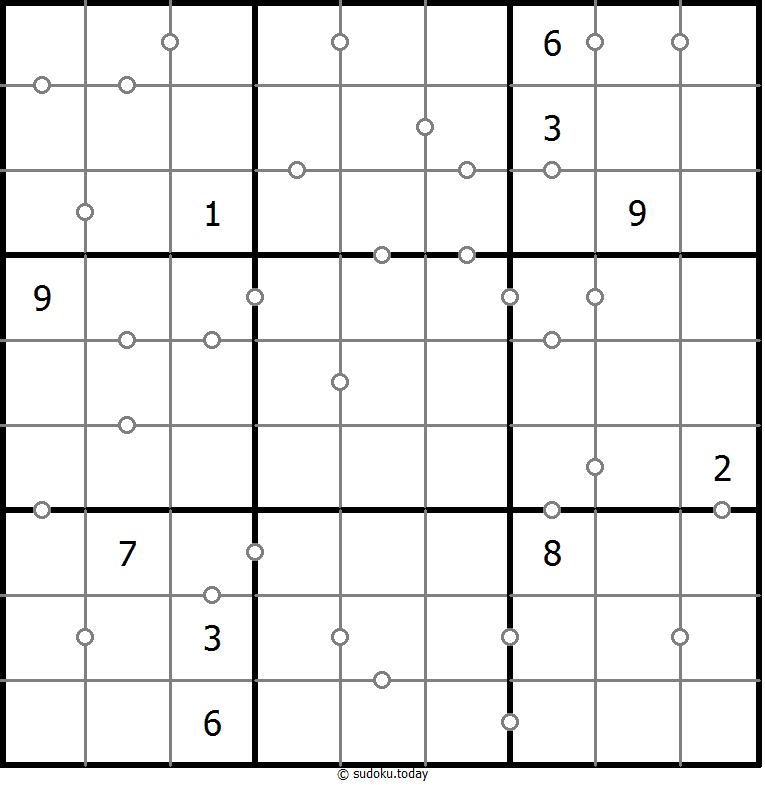
Consecutive Sudoku
- Place a digit from 1 to 9 into each of the empty squares so that each digit appears exactly once in each of the rows, columns and the nine outlined 3x3 regions.
- There are some dots between cells. The numbers on each side of a dot must always be consecutive. All possible dots are marked.
